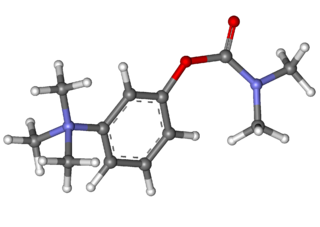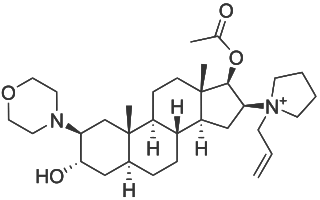
Pancuronium is an aminosteroid muscle relaxant with various medical uses. It is used in euthanasia and is used in some states as the second of three drugs administered during lethal injections in the United States.

Edrophonium is a readily reversible acetylcholinesterase inhibitor. It prevents breakdown of the neurotransmitter acetylcholine and acts by competitively inhibiting the enzyme acetylcholinesterase, mainly at the neuromuscular junction. It is sold under the trade names Tensilon and Enlon.

Neostigmine, sold under the brand name Bloxiverz, among others, is a medication used to treat myasthenia gravis, Ogilvie syndrome, and urinary retention without the presence of a blockage. It is also used in anaesthesia to end the effects of non-depolarising neuromuscular blocking medication. It is given by injection either into a vein, muscle, or under the skin. After injection effects are generally greatest within 30 minutes and last up to 4 hours.

Vecuronium bromide, sold under the brand name Norcuron among others, is a medication used as part of general anesthesia to provide skeletal muscle relaxation during surgery or mechanical ventilation. It is also used to help with endotracheal intubation; however, agents such as suxamethonium (succinylcholine) or rocuronium are generally preferred if this needs to be done quickly. It is given by injection into a vein. Effects are greatest at about 4 minutes and last for up to an hour.

Neuromuscular-blocking drugs, or Neuromuscular blocking agents (NMBAs), block transmission at the neuromuscular junction, causing paralysis of the affected skeletal muscles. This is accomplished via their action on the post-synaptic acetylcholine (Nm) receptors.

Rocuronium bromide is an aminosteroid non-depolarizing neuromuscular blocker or muscle relaxant used in modern anaesthesia to facilitate tracheal intubation by providing skeletal muscle relaxation, most commonly required for surgery or mechanical ventilation. It is used for standard endotracheal intubation, as well as for rapid sequence induction (RSI).

Rapacuronium bromide is a rapidly acting, non-depolarizing aminosteroid neuromuscular blocker formerly used in modern anaesthesia, to aid and enable endotracheal intubation, which is often necessary to assist in the controlled ventilation of unconscious patients during surgery and sometimes in intensive care. As a non-depolarizing agent it did not cause initial stimulation of muscles before weakening them.

Gallamine triethiodide (Flaxedil) is a non-depolarising muscle relaxant. It acts by combining with the cholinergic receptor sites in muscle and competitively blocking the transmitter action of acetylcholine. Gallamine is a non-depolarising type of blocker as it binds to the acetylcholine receptor but does not have the biological activity of acetyl choline. Gallamine triethiodide has a parasympatholytic effect on the cardiac vagus nerve, which causes tachycardia and occasionally hypertension. Very high doses cause histamine release.
Presence of iodine makes it radio opaque, and its ampule in a bag at airport's x-ray scanner raise the false suspicion of a bullet in the bag.

Aminosteroids are a group of steroids with a similar structure based on an amino-substituted steroid nucleus. They are neuromuscular blocking agents, acting as competitive antagonists of the nicotinic acetylcholine receptor (nAChR), and block the signaling of acetylcholine in the nervous system. These drugs include candocuronium iodide, dacuronium bromide, dihydrochandonium, dipyrandium, malouetine, pancuronium bromide, pipecuronium bromide, rapacuronium bromide, rocuronium bromide, stercuronium iodide, and vecuronium bromide.

Sugammadex, sold under the brand name Bridion, is a medication for the reversal of neuromuscular blockade induced by rocuronium and vecuronium in general anaesthesia. It is the first selective relaxant binding agent (SRBA). It is marketed by Merck.

Alcuronium chloride is a neuromuscular blocking (NMB) agent, alternatively referred to as a skeletal muscle relaxant. It is a semi-synthetic substance prepared from C-toxiferine I, a bis-quaternary alkaloid obtained from Strychnos toxifera. C-toxiferine I itself has been tested for its pharmacological action and noted to be a very long acting neuromuscular blocking agent For a formal definition of the durations of actions associated with NMB agents, see page for gantacurium. The replacement of both the N-methyl groups with N-allyl moieties yielded N,N-diallyl-bis-nortoxiferine, now recognized as alcuronium.

Fazadinium bromide is a muscle relaxant which acts as a nicotinic acetylcholine receptor antagonist through neuromuscular blockade.
Selective relaxant binding agents (SRBAs) are a new class of drugs that selectively encapsulates and binds neuromuscular blocking agents (NMBAs). The first drug introduction of an SRBA is sugammadex. Sugammadex is a modified gamma cyclodextrin that specifically encapsulates and binds the aminosteroid NMBAs: rocuronium>vecuronium>>pancuronium. SRBAs exert a chelating action that effectively terminates an NMBA ability to bind to nicotinic receptors.

Gantacurium chloride is a new experimental neuromuscular blocking drug or skeletal muscle relaxant in the category of non-depolarizing neuromuscular-blocking drugs, used adjunctively in surgical anesthesia to facilitate endotracheal intubation and to provide skeletal muscle relaxation during surgery or mechanical ventilation. Gantacurium is not yet available for widespread clinical use: it is currently undergoing Phase III clinical development.

Candocuronium iodide is a aminosteroid neuromuscular-blocking drug. Its use within anesthesia for endotracheal intubation and for providing skeletal muscle relaxation during surgery or mechanical ventilation was briefly evaluated in clinical studies in India, though further development was discontinued due to attendant cardiovascular effects, primarily tachycardia that was about the same as the clinically established pancuronium bromide. Candocuronium demonstrated a short duration in the body, but a rapid onset of action. It had little to no ganglion blocking activity, with a greater potency than pancuronium.

Dipyrandium is an aminosteroid neuromuscular blocking agent.

Dihydrochandonium is an aminosteroid non-depolarizing neuromuscular blocking agent.

Malouetine is an aminosteroid neuromuscular blocking agent and antinicotinic alkaloid isolated from Malouetia spp.

Stercuronium iodide is an aminosteroid neuromuscular blocking agent which was never marketed. It acts as a competitive antagonist of the nicotinic acetylcholine receptor (nAChR), and is also reported to be an acetylcholinesterase inhibitor.

Dacuronium bromide is an aminosteroid neuromuscular blocking agent which was never marketed. It acts as a competitive antagonist of the nicotinic acetylcholine receptor (nAChR).



















